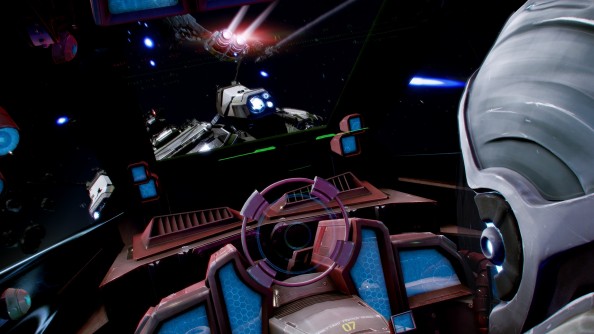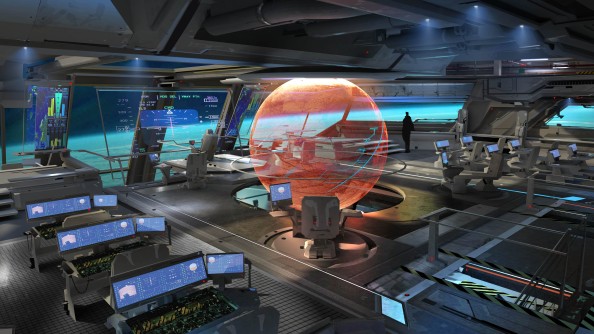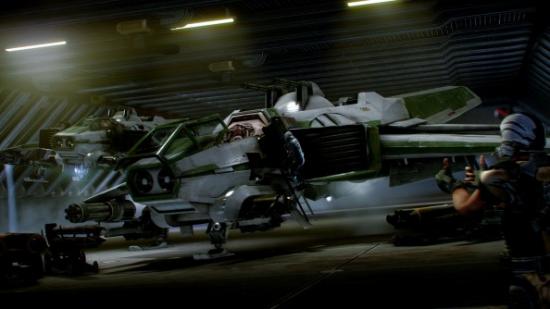Chris Roberts is back. He’s the man who created the legendary, ubercool sci-fi dogfighting series that was Wing Commander and, with it, helped to establish to PC as a gaming platform, pushing its hardware to the limit. He took players to the far reaches of the galaxy and gave them an original, epic space opera to lose themselves in, before becoming tired of the industry and becoming a Hollywood producer. Now, more than twenty years after the first Wing Commander game, he told me how he’s going to do it all over again with Star Citizen, his new, massively multiplayer space combat game, and then he showed me something very, very pretty.
And I mean all of it again. The frantic dogfights, the space opera and most definitely the pushing of the PC as a gaming platform. When I sit down with Roberts to go through a very early build of Star Citizen the game looks astonishingly good. He tells me he’s not interested in developing a cross-platform title that’s mindful of the architecture and the strict limitations of a console, whether the current generation’s or the next. No, Chris Roberts wants to make something for people who have big fat gaming PCs with big fat graphics cards, people who eat 8 gigabyte sticks of RAM for breakfast.
As starfighters streak through space, as a great carrier glides past the camera, I can see just how much detail has gone into every model. Not only are their textures very high resolution, with the shiny surfaces of each craft reflecting multiple light sources, there’s so, so many polygons, so many raised surfaces, so many individually-modelled components that are intricate in their detail: connectors, cables and even distinct rivets. Rivets, for heaven’s sake. As I try my best to take in all these details, Roberts tells me that a typical vehicle in this demo is about ten times as detailed, by polygon count, as any featured in a current triple-A game, and that he plans to make PC gaming more beautiful than ever. About as beautiful as this, in fact:
“The PC’s really important to me, I think it’s an under-served community,” he says. “Part of my goal is to say ‘Hey, look, I’m really focusing on the PC and I’m going to build something that will push your PC forward like my old games used to.’” Yes, I think to myself, he’s certainly going to do that.
“I’m a PC gamer in my heart, but I have consoles at home and I tend to buy the console version of a game that’s built for a console because I don’t want to play it on the PC,” he goes on. “But if someone was building a game that really pushed the limits of the PC, and said this is what it can be if you dream it, then I think I’d definitely buy that. That’s one of the big reasons for me to come back.“ Just to be clear, like the video above, these screenshots aren’t pre-rendered cutscenes. They’re typical of what the game looks like when it’s running.
Taking control of a pilot outside of their ship, Roberts walks around a carrier flight deck which is populated by dozens of ships and detailed down to the separate parts of each pilot’s flight suit. There’s probably around a million polygons on screen, Roberts tells me, as he climbs into a large starfighter to take off. As the door to the flight deck slides open, I see that the mechanism that controls it is made up of several moving parts that seem to function and respond to one another in real time. At the same time, his ship seems to be doing this, too, with cables twisting and deforming as gun turrets rotate, jets and thrusters changing position according to how he moves his joystick.
“In terms of a physics model, everything’s rendered and modelled physically correctly,” Roberts explains as he rolls and banks his ship. “If we take a look, as I’m yawing, you’ll see that my thrusters on top are articulating to give the thrust in the correct place to rotate, the proper pitch when I bank.” Yes, yes they are. “This ship isn’t set up to roll at thirty degrees a second, it’s actually modelled properly. It’s a full rigid body and it has these thrusters at different points.”
Yes, the vessel’s flight model is calculated in real-time based on how all its individual components behave, rather than simply existing as a hard-coded set of values. That means that if particular components are damaged or destroyed, the ship handles differently. In other words, if the thrusters that help you to turn right are kaput, then you ain’t turning right any more, same for the engines, the guns, the… everything. Your ship is the sum of its parts.
All this quite enough for me as it is. I’d be perfectly happy if Chris Roberts was showing off a new and very good-looking space combat game that’s just bristling with detail, possibly one that I could play online with my friends. Sure. Fine. Great! Wow! But as his short walk outside of the cockpit demonstrated, this isn’t even a tiny slice of a much, much bigger pie, it’s a goddamn flake of pastry. Star Citizen will be a Wing Commander-style game set inside a much wider universe.
Roberts’ plan is for a massively-multiplayer space combat game “inspired by the decline and fall of the Roman Empire,” and closer to Elite than to EVE Online. In a similar model to Guild Wars 2, players will pay a one-time fee to enter the game (in character, this is their payment for their first ship) and, like the Romans of old, will have to work to earn their citizenship in this galactic empire.
“You earn your citizenship through military duty, or you could earn it by civic duty, or if you’re a merchant and you make a lot of money you could buy your citizenship, all something that players would aim to achieve as they’re playing,” says Roberts. It’s only a small fraction of the military part of the game, featuring the elite “foreign-legion”-style Squadron 42, that he’s been demonstrating to me. “It’s an open world where if you want to be a soldier, you want to be a mercenary, you want to be a pirate, you want to be a bounty hunter, you want to be an explorer, you can do all that. Plus, there’s a dynamic economy which is something I wanted to see back in the Freelancer days.”
As well as his work on the Wing Commander series, Roberts also helped to create the Elite-inspired Privateer and Freelancer. The former was set in the same universe as Wing Commander, while the latter was the title that would leave him “burned out on the industry.” Announced in 1999, Freelancer was to be an ambitious Elite-style game set in an intelligent, dynamic and massively multiplayer galaxy. It suffered setbacks and eventually saw release in 2003, lacking many of the features Roberts had hoped to include. To help finance the game, Roberts sold his company, Digital Anvil, to publishers Microsoft with the belief that they would stay true to his original vision.
It wasn’t to be so, and “Microsoft just wanted to get it out and that was kind of it.” When Freelancer was finally released it lacked many of the features Roberts had wanted. Having already directed a Wing Commander film, Roberts decided to stick with Hollywood, going on to produce films like Lucky Number Slevin and the Nicholas Cage feature Lord of War, though he tells me he’d always wanted to “finish off” Freelancer, which is why he’s trying again, only on a far greater scale.
The time is right, he says, because of new, proven business models and a growing focus on community engagement in PC gaming. He can, he says, now make the kind of game that wouldn’t have been possible a decade ago and sell it straight to his audience without the complications presented by a publisher, while constantly shaping it according to demand. Roberts’ plan for Star Citizen is to build the galaxy according to what it’s community say they enjoy and, along the way, mold its story in response to how they behave and what they enjoy. It’s something he describes as being similar to a giant game of Dungeons & Dragons.
“It’s really important to me to build this universe in a live fashion, so that the players who’re playing it feel like it’s responsive to them and they’re integrated into it,” he says. “It’s almost like an improv storytelling, or like we’re a dungeon master, riffing off what people are saying, but the idea is we’d do it in the game itself. The idea is, instead of monolithic updates that you see in some games, that you see once a year or once every two years, like World of Warcraft or EVE Online, we want to do micro updates all the time.
“I’m not necessarily saying we’re going to put in a new star system every day, but this week there could be a new star system that we drop into the galaxy, or the next week it could be a five mission story sequence that happens over in this side of the galaxy, and all this stuff that we start to do, the idea is that it riffs off what’s happening in the universe.”
Roberts hopes to be responding to his community right from the start, as he wants Star Citizen to be partly crowdfunded, with those who contribute immediately able to join the alpha and begin making their mark on the galaxy. In the meantime, the early stages of the game’s development have been funded and developed privately, with “some of my old compatriots from Wing Commander,” so that Roberts can present the public a build that shows just how serious he is about this project.
“I think there’s a lot of people have said ‘Hey, I’m doing this, give me some money! Trust me, I’ll make a good game!’ The approach here is a little different,” he says. “I’ve gone off and spent a year building this to show you how I want PC games to be. I believe in this, and if you guys believe, enough of you, please come in and purchase early so I can finish this off. And if you do, you’re going to be allowed some very cool stuff and be part of the development process and play it well before anyone else.”
The idea of an entire galaxy built to same the level of detail that matches his demo just boggles my mind, and his ambition echoes through the many other features he reels off. If I wanted to sign up for service in the military and fly the kind of Squadron 42 ships that Roberts is showing me in the demo, then I could expect to lose out on the freedom of open-world exploration, but I could play through many of the military campaigns either online or offline. “If you play it online then your friends can join in on your wing on missions, like Demon’s Souls, where you have people jump in to kill a boss.”
Similarly, though this is an MMO project at heart, Roberts also wants players to be able to run their own servers, albeit reduced in scope, but with the ability to customise them. “Not necessarily a big, persistent world, because I don’t think they’ll have that capability, but a more limited version of the universe they could run on their own server. They can mod it, they can do whatever they want, add their own content.” He would also like to add support for the Oculus Rift VR headset, which he says would be “perfect” for when you’re sat in the cockpit, where most of the action will take place.
Most of it, but not all. Those brief moment where Roberts walked around the carrier flight deck as a pilot demonstrates how he images players moving around inside capital ships and space stations, interacting not only with each other but also with intelligent NPCs who will respond to each player according to their reputation and behaviour. Flying past the bridge of the carrier, we catch sight of a few crew members through the windows and he tells me these could easily be your friends, waving at you as you shoot past. There are no separate instances here.
I’m almost bowled over by Roberts’ ambition. Star Citizen boasts a level of graphical fidelity that’s rarely seen, rarely even hinted at, and while his vision of a living galaxy may have been considered unrealistic ten years ago, EVE Online has proved that such a thing is possible. Much as he did with Freelancer, the only things that Roberts really needs are time and money. He says the full game is about two years away, “but we’ll have a multiplayer build set in the universe that you can match up in, like World of Tanks, in about a year. If you’re one of the early pre-buyers, you’ll get that, you’ll get to play the alpha, so you’re playing a full year or so before anyone else is going to be playing, you’re involved in the community.”
A year suddenly feels like an impossibly long time to wait for such a game, while I’m pretty sure a two year wait is some sort of human rights abuse. Of course, so much could change in that time and I’ll be interested to see just how much community feedback does shape the tone and development of the game (something you can keep up with on the website here). Star Citizen could very well be Chris Roberts’ triumphant return to the games industry and with Dishonored and XCOM just released, it’s now top of my wanted list. When this goes up for crowdfunding, you’d damn well better fund it. All of you.
